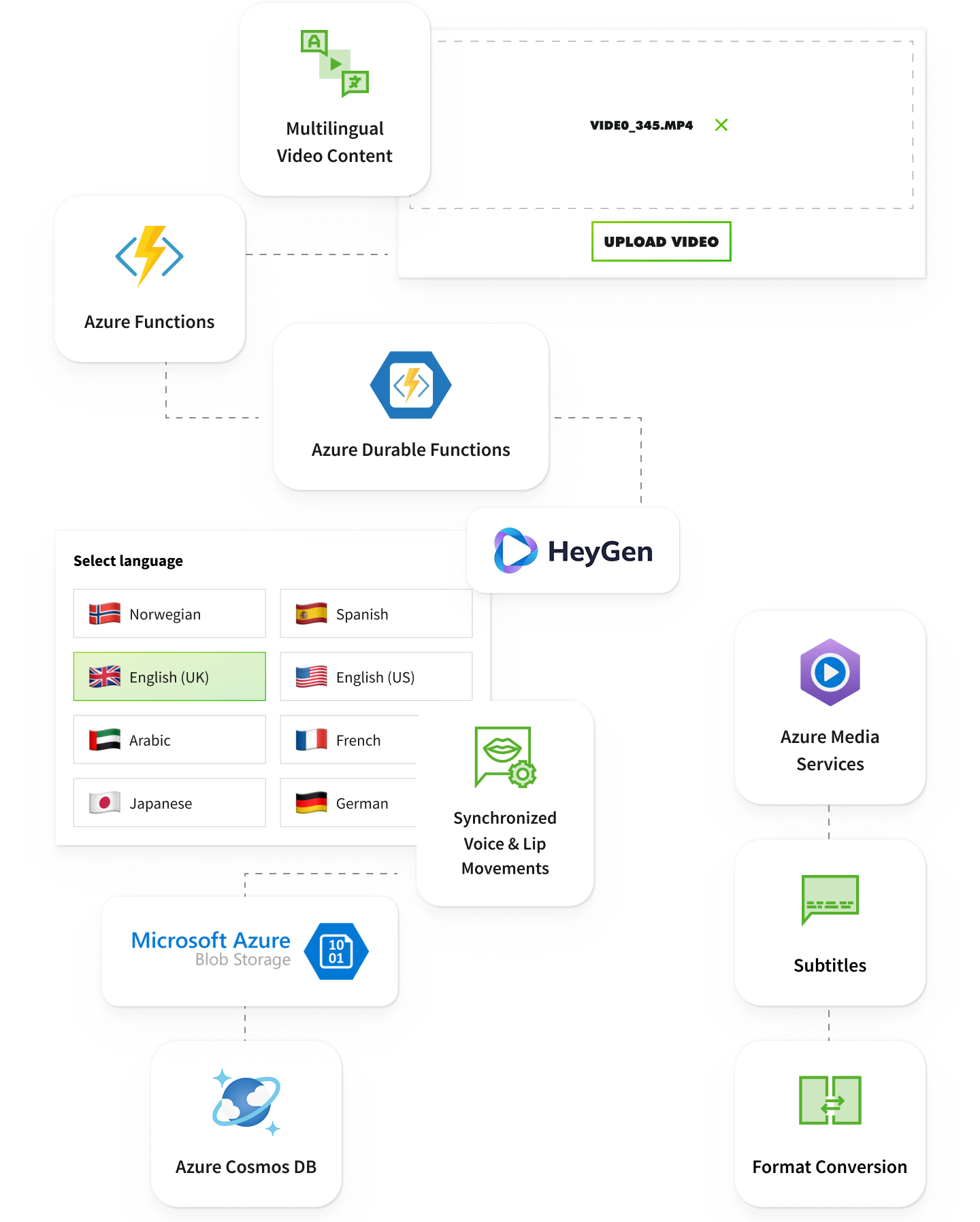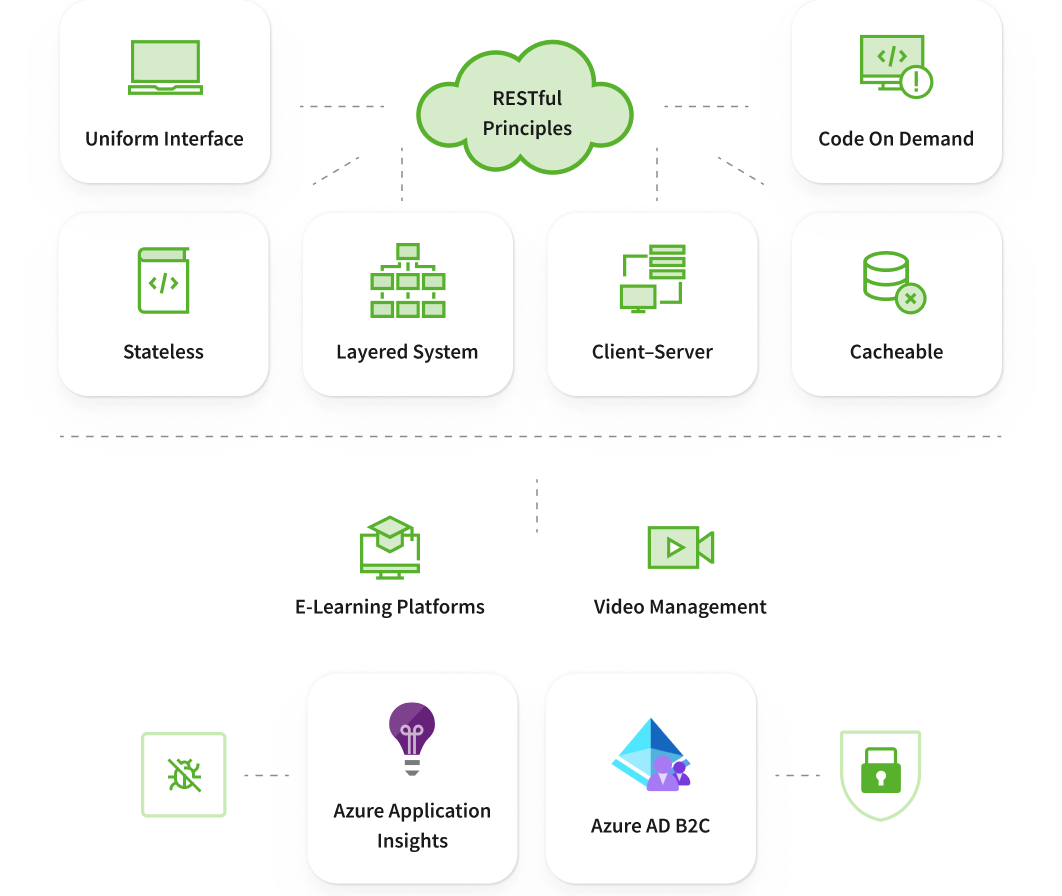AI-Powered Video Translation Platform
AI-powered PoC development that ensures automatic translation of videos with realistic lip-sync and voice cloning
ABOUT the project
- Client:
- Leobit's Internal Project
- Location:
-

USA
- Company Size:
- 100+ Employees
- Industry:
- Software Development
- Solution:
- Custom Software Development
Services:
This proof of concept showcases cutting-edge AI-powered video translation technology, which enables seamless multilingual content delivery. Powered by an advanced AI voice cloning and lip-sync technology, this solution generates natural-sounding translated audio that closely matches the original speaker’s voice characteristics. The intelligent lip-sync engine ensures visual authenticity by synchronizing mouth movements with the translated speech to deliver a truly immersive multilingual viewing experience.
We underwent a thorough R&D process, researching various existing tools, testing them, and eventually selecting HeyGen because it delivered the best results and offered robust API capabilities. Following this, we developed a prototype for an automated video translation process, hosting the solution on the Azure cloud.

Customer
Leobit’s R&D team embarked on a two-week experimental project to explore how artificial intelligence could enhance the quality and efficiency of video content dubbing. The primary objective was to create a lightweight, AI-powered proof of concept that would translate video content into multiple languages while preserving its visual and emotional authenticity.
Business Challenge
Global content distribution requires significant resources for manual translation and localization. Our PoC demonstrates how AI can eliminate language barriers by automatically translating video content while maintaining visual authenticity through advanced lip-sync technology and voice cloning capabilities. This solution addresses the growing demand for multilingual content in educational platforms, corporate training, marketing campaigns, and international communication.
Why Leobit
This initiative built upon Leobit’s prior experience with AI-powered solutions and cloud-native architectures. The PoC served both as a technical experiment and a foundation for future client solutions in the media, education, and enterprise sectors.
Project
in detail
Leobit successfully delivered a robust PoC that demonstrates the potential of AI in transforming multilingual video content.



Integration with HeyGen API
Leobit’s integration with the HeyGen API served as the backbone of the PoC’s AI-powered video translation capabilities. During the first week of development, our developer thoroughly analyzed HeyGen’s documentation and capabilities to design a modular back-end workflow using Azure Functions. The integration was structured around RESTful calls to HeyGen’s services, which enabled automatic video ingestion, language detection, translation, and AI-generated voiceovers with synchronized lip movements.
We used dependency injection within the .NET 8 back end to create loosely coupled service wrappers around the HeyGen endpoints. These service layers allowed for easier testing, monitoring, and error handling. The output from HeyGen was then passed to Azure Blob Storage for secure handling and stored metadata in Azure Cosmos DB to track processing status, logs, and language configurations.

Intelligent language detection
To enable automatic source language identification, Leobit implemented a dedicated Azure Function that handled initial video ingestion and language detection. Once a user uploaded a video through the Angular front end, the video file was securely stored in Azure Blob Storage. The back end then triggered a HeyGen API call to initiate language recognition.
The API returned a language code (e.g., en, de, fr), which was stored in Azure Cosmos DB along with a unique file identifier. This allowed the rest of the translation workflow to dynamically adapt based on the detected source language, without requiring any manual user input.

API integration ready
Leobit developed the back end in accordance with RESTful principles, which allow the PoC to evolve into a fully operational microservice or SaaS module that can be embedded into larger video management or e-learning platforms.
This makes the solution API-ready, allowing external applications to trigger video uploads, initiate translations, and retrieve results programmatically. All endpoints are protected with secure authentication via Azure AD B2C, and request logs are captured through Azure Application Insights for monitoring and debugging.
Explore
The solution prototype
Experience seamless AI-powered video translation. This proof of concept showcases cutting-edge dubbing technology, built with Angular 20 and .NET 8, and powered by Azure services and HeyGen AI to deliver intelligent, real-time video localization.
Technology Solution
- HeyGen API integration enables automatic language detection, contextual translation, lip-sync generation, and voice cloning.
- Serverless back end with .NET 8 and Azure Functions, which ensures cost efficiency and high availability without managing infrastructure.
- RESTful endpoints make it easy to integrate with external systems, content platforms, or enterprise applications for broader adoption.
- The user interface was developed using Angular 20, with standalone components and reactive signals, to ensure a smooth and responsive experience throughout the video upload and translation process.
Value Delivered
- By integrating advanced lip-sync and voice cloning technologies, the solution significantly enhances the realism and emotional impact of dubbed videos.
- Support for custom vocabulary and transcript enhancement means the system can be adapted for domain-specific content, ensuring translation accuracy and brand consistency.
